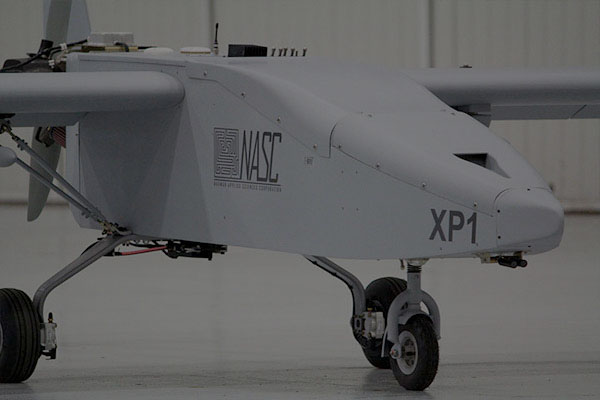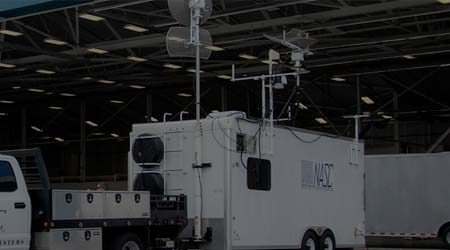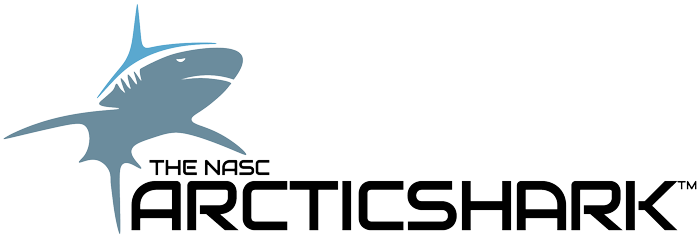
The NASC ArcticShark™ Unmanned Aerial Vehicle is a highly adaptable, aerial research platform that provides an observational base for multiple scientific research disciplines.
A purpose-designed variant of the highly successful and proven NASC TigerShark-XP™, the ArcticShark was conceived and constructed to operate in cold weather environments. Designed specifically for extreme climate survivability, the ArcticShark was modified and hardened to withstand the rigors of polar region operations. Additionally, the ArcticShark features an upgraded satellite command and control system for beyond visual line of sight operations.

The NASC ArcticShark™ Unmanned Aerial Vehicle is a highly adaptable, aerial research platform that provides an observational base for multiple scientific research disciplines.
A purpose-designed variant of the highly successful and proven NASC TigerShark-XP™, the ArcticShark was conceived and constructed to operate in cold weather environments. Designed specifically for extreme climate survivability, the ArcticShark was modified and hardened to withstand the rigors of polar region operations. Additionally, the ArcticShark features an upgraded satellite command and control system for beyond visual line of sight operations.

ArcticShark – A Versatile, Cold-Weather UAV Solution
The ArcticShark can be configured with varied wing and fuselage mounted instrumentation designed to sample various data in extreme latitudes. It incorporates a “Payload Plug and Play” system that minimizes cost and allows for the seamless integration of new and different research payloads. The open architecture airframe enables the ArcticShark to carry and employ multiple payloads simultaneously. Depending on the payload weight and power requirements, ArcticShark offers high endurance for its size even in cold weather.
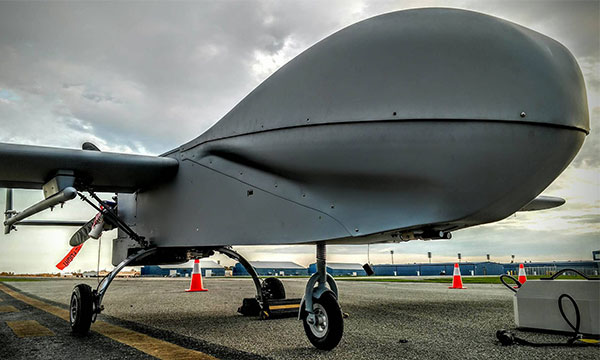
The NASC ArcticShark™ Cold Weather Upgrades:
- Heated pitot-static system.
- All avionics components hardened and tested to operate at or below temperatures of -20⁰ C.
- All servos modified with low-temperature lubricant. Tested to -20⁰ C and subjected to 500 hour continuous operation life cycle testing under normal load condition. Zero performance degradation or failure.
- EPDM weather seal gaskets incorporated on all access hatches, ports, and panels to preclude moisture intrusion/ice accumulation. Tested with zero degradation of performance to -20⁰ C.
- 4kW alternator to easily support integration of additional aircraft anti-ice/de-ice systems with no impact to mission systems.
- 60HP, fuel-injected engine precludes carburetor icing and provides robust climb performance to better enable avoidance of icing conditions.
- 48V deep cell battery and heavy duty external starter employed for reliable engine starting at lower temperatures.
- Engine oil systems (oil cooler, oil cooler restriction plates, externally mounted oil lines, etc.) tested for proper flow and heat stabilization at lower temperatures.
| A: Wingspan | 21′ 9″ (6.6m) |
| B: Length | 14′ 3″ (4.3m) |
| C: Ground to Top of Winglet | 3′ 9″ (1.1m) |
| D: Ground to Top of Tail Boom | 4′ 1″ (1.2m) |
| E: Ground Clearance | 1′ (0.3m) |
| F: Nose to Propeller | 9′ 2″ (2.8m) |
| G: Width of Fuselage | 25′ 6″ (7.8m) |
| H: Tail Boom Width | 4′ 4″ (1.3m) |
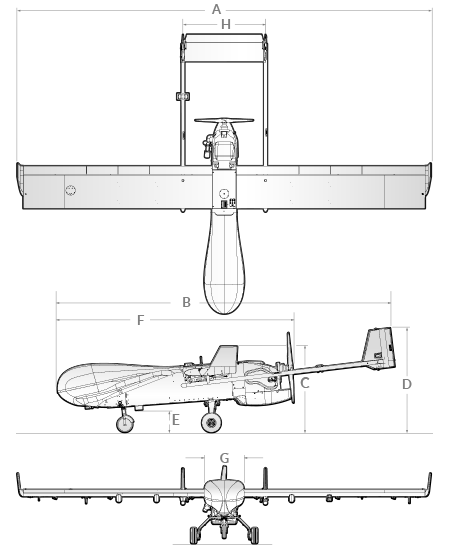
| General Specifications | |
| Engine | UEL 801, 50HP |
| Power Generation | 4.2kW Alternator |
| Propeller | 37″x36″ (940mm X 914mm) |
| Fuel Capacity | 20 gal. (76L) |
| Empty Weight | 469 lbs. *(209kg)* |
| Gross Weight | 650 lbs. (295kg) |
| CG Range | 31-35% MAC |
| Best CG Range | 33% MAC (Zero fuel landing weight) |
| Payload Specifications | |
| Max. Payload Weight | 70 lbs.*(32 kg)* |
| Payload Bay Volume | Main Bay: 14′ 5″W x 19″D x 15″H (4,132 cu.in.) Main Bay: 368mm W x 483mm D x 381mm H (67,720 cu.cm.) |
| Payload Power Available | 2,000 Watts Max. |
| Wing Stores | |
| Max. Combined Hard Points Per Wing | 50 lbs. (22.7kg) |
| Max. Inner Hard Points | 35 lbs. (15.9kg) |
| Max. Outer Hard Points | 30 lbs. (13.6kg) |
| Max. Combined Left/Right Wing Hard Points Delta | 20 lbs. (9.0kg) |
| Max. Wing Tip Store | 20 lbs. (9.0kg) |
| Max. Tailboom Payload** | 10 lbs. (4.5kg) per boom |
| Frequencies | |
| Autopilot | Please contact NASC at 215-675-4949 with your frequency questions. |
| Secondary Comms. | Please contact NASC at 215-675-4949 with your frequency questions. |
| Video Transmitter | Please contact NASC at 215-675-4949 with your frequency questions. |
| IFF Transponder | Sagetech ADS-B Out 1090 MHZ Tx, 1030 MHz Rx (Transponder Mode 3A/C Compatible) |
| GPS | L1-1575.42 MHz |
| DGPS | L1-1575.41 MHz / L2 – 1227.60 MHZ |
| Flight Performance | |
| Max. Altitude | 18,000 ft. (5,486m) MSL* |
| Max Speed | 80 Kts* |
| Loiter Speed | 60-65 Kts IAS |
| Stall Speed | 54 Kts @ 580 lbs. (263kg) Zero Flaps/51 Kts Full Flaps |
| Max. Operating Wind Speed | 25 Kts |
| Max. Crosswind | 15 Kts |
| Takeoff Speed | 58 Kts @ 580 lbs. (263kg) Zero Flaps* |
| Landing Distance | Wheeled with Hydraulic Breaking, 700 ft. (214m) Rollout |
| Endurance | 8+ Hours with 12 lbs. (5.4kg) Fuel Reserve (Depending on fuel and payload)* |
† Dependent on payload weight.
* Estimated – Actual value dependent on performance and/or integration of selected payload.
** Please contact NASC at 215-675-4949 for alternative tailboom mount locations and corresponding weight limits.
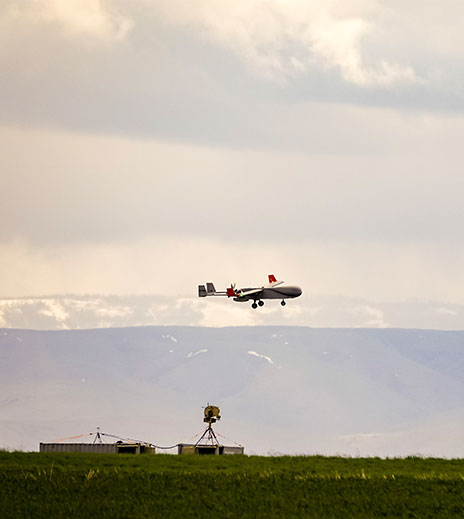
Atmospheric Research Platform
Communications Relay Platform
Low-Cost Research & Development Platform
Geological & Terrain Mapping
Meteorological Reasearch Center
ArcticShark™ Video

| A: Wingspan | 21′ 9″ (6.6m) |
| B: Length | 14′ 3″ (4.3m) |
| C: Ground to Top of Winglet | 3′ 9″ (1.1m) |
| D: Ground to Top of Tail Boom | 4′ 1″ (1.2m) |
| E: Ground Clearance | 1′ (0.3m) |
| F: Nose to Propeller | 9′ 2″ (2.8m) |
| G: Width of Fuselage | 25′ 6″ (7.8m) |
| H: Tail Boom Width | 4′ 4″ (1.3m) |
| General Specifications | |
| Engine | UEL 801, 50HP |
| Power Generation | 4.2kW Alternator |
| Propeller | 37″x36″ (940mm X 914mm) |
| Fuel Capacity | 20 gal. (76L) |
| Empty Weight | 469 lbs. *(209kg)* |
| Gross Weight | 650 lbs. (295kg) |
| CG Range | 31-35% MAC |
| Best CG Range | 33% MAC (Zero fuel landing weight) |
| Payload Specificatons | |
| Max. Payload Weight | 70 lbs.*(32 kg)* |
| Payload Bay Volume | Main Bay: 14′ 5″W x 19″D x 15″H (4,132 cu.in.) Main Bay: 368mm W x 483mm D x 381mm H (67,720 cu.cm.) |
| Payload Power Available | 2,000 Watts Max. |
| Wing Stores | |
| Max. Combined Hard Points Per Wing | 50 lbs. (22.7kg) |
| Max. Inner Hard Points | 35 lbs. (15.9kg) |
| Max. Outer Hard Points | 30 lbs. (13.6kg) |
| Max. Combined Left/Right Wing Hard Points Delta | 20 lbs. (9.0kg) |
| Max. Wing Tip Store | 20 lbs. (9.0kg) |
| Max. Tailboom Payload** | 10 lbs. (4.5kg) per boom |
| Frequencies | |
| Autopilot | Please contact NASC at 215-675-4949 with your frequency questions. |
| Secondary Comms. | Please contact NASC at 215-675-4949 with your frequency questions. |
| Video Transmitter | Please contact NASC at 215-675-4949 with your frequency questions. |
| IFF Transponder | Sagetech ADS-B Out 1090 MHZ Tx, 1030 MHz Rx (Transponder Mode 3A/C Compatible) |
| GPS | L1-1575.42 MHz |
| DGPS | L1-1575.41 MHz / L2 – 1227.60 MHZ |
| Flight Performance | |
| Max. Altitude | 18,000 ft. (5,486m) MSL* |
| Max Speed | 80 Kts* |
| Loiter Speed | 60-65 Kts IAS |
| Stall Speed | 54 Kts @ 580 lbs. (263kg) Zero Flaps/51 Kts Full Flaps |
| Max. Operating Wind Speed | 25 Kts |
| Max. Crosswind | 15 Kts |
| Takeoff Speed | 58 Kts @ 580 lbs. (263kg) Zero Flaps* |
| Landing Distance | Wheeled with Hydraulic Breaking, 700 ft. (214m) Rollout |
| Endurance | 8+ Hours with 12 lbs. (5.4kg) Fuel Reserve (Depending on fuel and payload)* |
† Dependent on payload weight.
* Estimated – Actual value dependent on performance and/or integration of selected payload.
** Please contact NASC at 215-675-4949 for alternative tailboom mount locations and corresponding weight limits.



